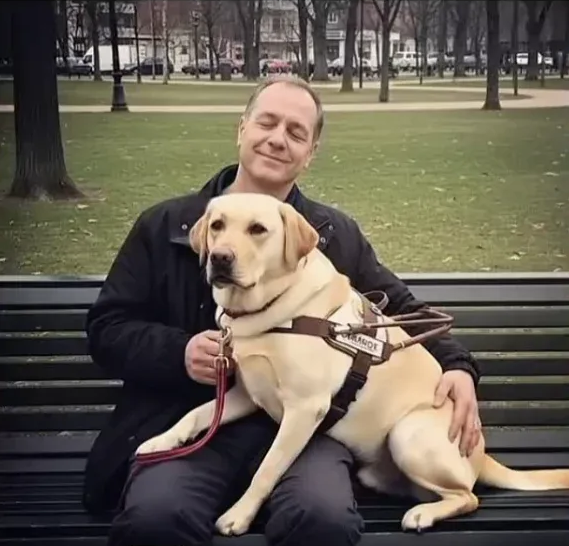
September 11th, 2001. Michael Hingson was on the 78th floor of the North Tower when the plane hit. He’s blind, dependent on his guide dog Roselle for navigation through the world. And suddenly the world had become chaos—smoke, screaming, confusion, the building shaking from an impact no one yet understood.
People panic in moments like that. It’s natural, inevitable, the survival instinct taking over in ways that aren’t always rational. But Roselle didn’t panic. The yellow Labrador remained perfectly calm, as if the chaos around her was just another day at work.
She expertly led Michael and a group of others down 1,463 steps to safety. Not rushed. Not frantic. Just steady, focused, doing the job she’d been trained to do even when everything around her screamed danger.
Fourteen hundred sixty-three steps. That’s not a quick descent. That’s a marathon of stairs in smoke-filled stairwells with thousands of people evacuating, with uncertainty about whether the building would hold, with every instinct screaming to move faster even though faster isn’t always safer.
Roselle paused only once during that entire descent. Not because she was tired. Not because she was scared. But to lick the face of and comfort a woman paralyzed by a panic attack.
Think about that. In the middle of one of America’s worst disasters, while leading her blind owner and others down 1,463 steps through smoke and chaos, this guide dog stopped to comfort a stranger having a panic attack. She recognized distress and responded with compassion, then continued her mission.
They escaped just minutes before the tower fell. Minutes. If Roselle had panicked, if she’d rushed, if she’d been anything less than perfectly calm and focused, Michael Hingson might not have made it out. The people following them might not have made it out.
The photo shows them years later—Michael sitting on a park bench with Roselle beside him, the yellow Lab calm and dignified, wearing her guide dog harness. They’re in a peaceful park, trees in the background, the chaos of September 11th long past but never forgotten.
Michael’s hand rests on Roselle, the bond between them visible in that simple contact. This is the dog who saved his life. Who remained calm when everyone else was panicking. Who led him through hell with the same steady competence she showed on ordinary days.
Guide dogs are extraordinary. They’re trained to navigate complex environments, to make decisions their handlers can’t make for themselves, to be eyes for people who don’t have them. But training only goes so far. What Roselle displayed on September 11th went beyond training—it was character, intelligence, an almost supernatural calm in the face of disaster.
She could have panicked. Dogs have the same survival instincts humans do. They feel fear. But Roselle channeled her training and her nature into focus, into doing the job she was meant to do, into being the steady presence Michael needed when the world was falling apart.
The moment she stopped to comfort the woman having a panic attack reveals something profound about Roselle’s nature. She wasn’t just following commands or executing training. She was thinking, assessing, recognizing that someone needed help and providing it even in the middle of her own mission.
That’s not just a well-trained dog. That’s a hero with four legs and a yellow coat.
Michael Hingson survived September 11th because of Roselle. So did the people who followed them down those 1,463 steps, trusting this calm yellow Lab to lead them to safety. They lived because one guide dog refused to panic, refused to rush, refused to let chaos dictate her response.
Roselle has since passed away, but her story lives on as one of the most remarkable examples of canine heroism. She’s been honored, celebrated, remembered as the dog who led people to safety when the world was ending around them.
But more than the accolades, Roselle represents something we need to remember: that sometimes the calmest voice in the chaos is the one that saves us. That panic is natural but composure is powerful. That training matters, but character matters more.
Fourteen hundred sixty-three steps. One calm guide dog. Multiple lives saved. And one pause to comfort a stranger, because even in disaster, compassion matters.
Michael Hingson will never forget his guide dog Roselle. Neither should we. She showed us what heroism looks like when it has four legs, a wagging tail, and the steadiest heart imaginable.